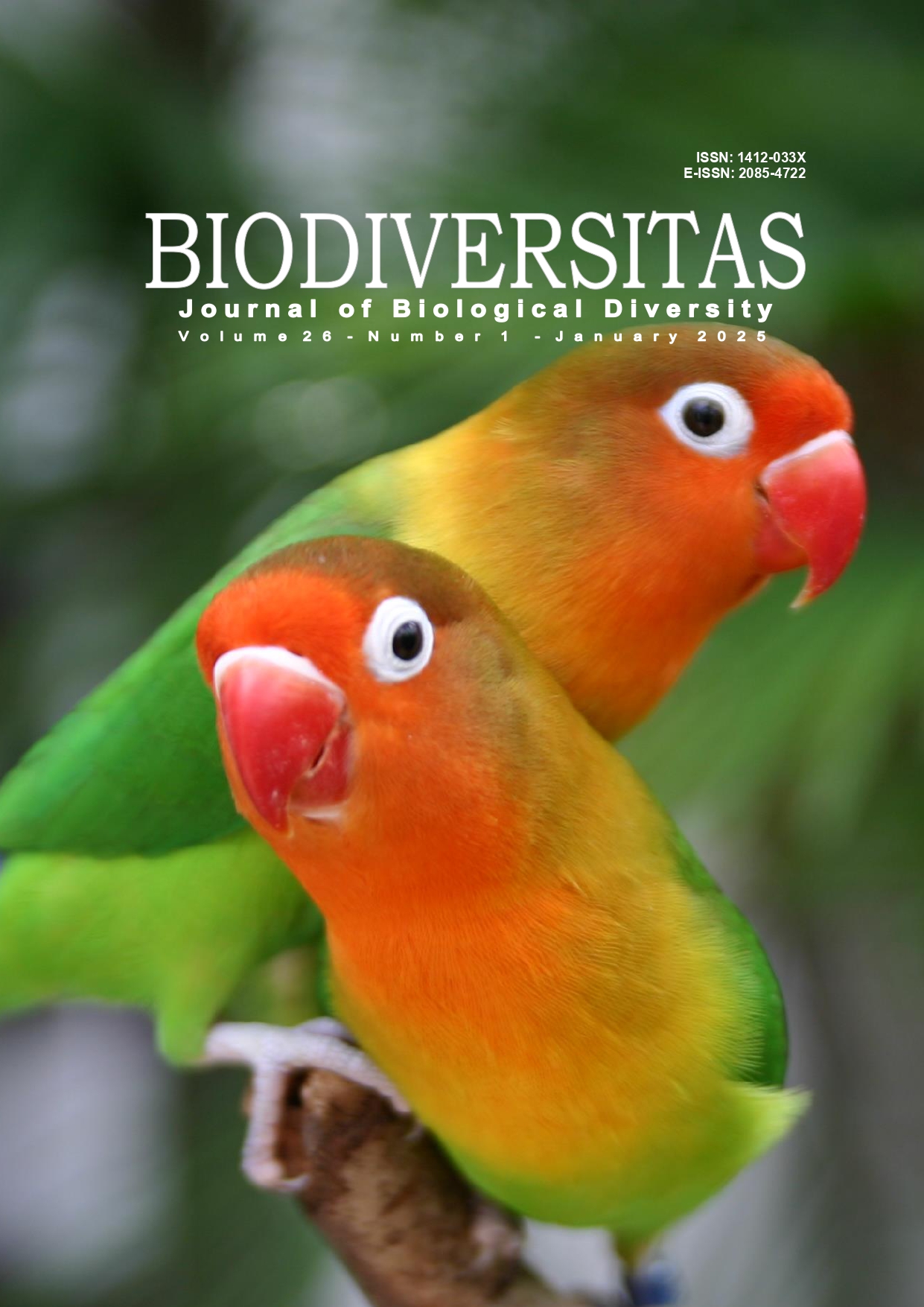Abundance of adult Aedes aegypti and Ae. albopictus (Diptera: Culicidae) across six settlements in South Sulawesi, Indonesia
##plugins.themes.bootstrap3.article.main##
Abstract
Abstract. Saputra FR, Wahid I, Supriyono, Hadi UK. 2025. Abundance of adult Aedes aegypti and Aedes albopictus (Diptera: Culicidae) across six settlements in South Sulawesi, Indonesia. Biodiversitas 26: 509-519. Aedes aegypti and Ae. albopictus are major vectors of dengue, chikungunya, and Zika. These diseases impose a significant global health burden, particularly in tropical and subtropical regions where environmental conditions favor mosquito population growth and disease transmission. This study aimed to analyze the abundance of adult Ae. aegypti and Ae. albopictus across six settlements in South Sulawesi Province, Indonesia. Mosquito collections were conducted from January to October 2023. The selected settlements were Manuju, Pangembang, Tamala’lang, Adatongeng, Lae-Lae, and Panaikang. The findings indicated that Ae. aegypti was predominantly found indoors in Lae-Lae, with a total of 696 individuals (58.7%) from 100 surveyed houses, while Ae. albopictus was mostly found indoors in Pangembang, with 31 individuals (55.4%). Outdoors, Ae. aegypti was most abundant in Lae-Lae, where 32 individuals (80.0%) were captured in vegetated areas around 100 surveyed houses, such as near bamboo trees and other vegetation surrounding the settlements Similarly, Ae. albopictus was more frequently found outdoors in the same area, with 177 individuals (33.1%) captured under similar conditions. In total, Ae. aegypti was primarily found indoors, with 1186 individuals (p<0.01), while Ae. albopictus was mainly found outdoors, with 535 individuals (p<0.001). These findings reveal significant differences in the abundance of these mosquito species between indoors and outdoors, highlighting the influence of local environmental factors on their distribution in South Sulawesi Province, Indonesia.
##plugins.themes.bootstrap3.article.details##
Most read articles by the same author(s)
- ARINI RATNASARI, ARIF RAHMAN JABAL, NUR RAHMA, SRI NUR RAHMI, MILA KARMILA, ISRA WAHID, The ecology of Aedes aegypti and Aedes albopictus larvae habitat in coastal areas of South Sulawesi, Indonesia , Biodiversitas Journal of Biological Diversity: Vol. 21 No. 10 (2020)
- M. IKHSAN, UPIK KESUMAWATI HADI, SUSI SOVIANA , Diversity and distribution bromeliads plants as breeding habitat for mosquito larvae (Diptera: Culicidae) in Bogor, Indonesia , Biodiversitas Journal of Biological Diversity: Vol. 21 No. 8 (2020)
- ARINI RATNASARI, ARIF RAHMAN JABAL, SYAHRIBULAN, IRFAN IDRIS, NUR RAHMA, SRI NUR RAHMI NUR RUSTAM, MILA KARMILA, HAJAR HASAN, ISRA WAHID, Salinity tolerance of larvae Aedes aegypti inland and coastal habitats in Pasangkayu, West Sulawesi, Indonesia , Biodiversitas Journal of Biological Diversity: Vol. 22 No. 3 (2021)
- MEIS NANGOY, ERWIN SONDAKH, RONI KONERI, UPIK KESUMAWATI HADI, Fly species on cows around the Tangkoko Nature Reserve, North Sulawesi, Indonesia and their role as zoonotic disease vectors , Biodiversitas Journal of Biological Diversity: Vol. 23 No. 2 (2022)
- MUHAMMAD NIRWAN, UPIK KESUMAWATI HADI, SUSI SOVIANA, FADJAR SATRIJA, SURACHMI SETIYANINGSIH, Diversity, domination and behavior of mosquitoes in filariasis endemic area of Bogor District, West Java, Indonesia , Biodiversitas Journal of Biological Diversity: Vol. 23 No. 4 (2022)
- DEWI MARIA YULIANI, UPIK KESUMAWATI HADI, SUSI SOVIANA, ELOK BUDI RETNANI, Habitat characteristic and density of larva Aedes albopictus in Curug, Tangerang District, Banten Province, Indonesia 2018 , Biodiversitas Journal of Biological Diversity: Vol. 22 No. 12 (2021)
- SUPRIYONO, SUSI SOVIANA, DIMAS NOVIANTO, MUHAMMAD FALIKHUL MUSYAFFA, SURIYANI TAN, UPIK KESUMAWATI HADI, Morphological characteristic of malaria vector Anopheles aconitus (Family: Culicidae) revealed by advanced light and scanning electron microscope , Biodiversitas Journal of Biological Diversity: Vol. 23 No. 7 (2022)
- SUPRIYONO, SUSI SOVIANA, MUHAMMAD FALIKHUL MUSYAFFA, DIMAS NOVIANTO, UPIK KESUMAWATI HADI, Morphological characteristic of dengue vectors Aedes aegypti and Ae. albopictus (Family: Culicidae) using advanced light and scanning electron microscope , Biodiversitas Journal of Biological Diversity: Vol. 24 No. 2 (2023)
- MUNIRAH MUNIRAH , ISRA WAHID, FIRDAUS HAMID, SITTI WAHYUNI, Short Communication: The detection of Plasmodium in mosquitoes from Sumba and Sorong districts, Indonesia , Biodiversitas Journal of Biological Diversity: Vol. 22 No. 7 (2021)

